This paper originally appeared in The PRS Review, Pre-Raphaelite Women Special Issue, guest-edited by Dr Serena Trowbridge. It has been reformatted for this website by Taylor Tomko, with a few illustrations added from our own site, and six illustrations by Georgie McAusland for Christina Rossetti’s Goblin Market (London: Batsford, 2021) reproduced with permission of the artist and publisher. [Click on all the images to enlarge them.]
 irst published in 1862, Christina Rossetti's 'Goblin Market' narrates the story of sisters Laura and Lizzie, tempted by the cries of goblin merchants selling their delicious but treacherous fruit. Not intended as an allegory according to Rossetti, the uncertainty of the poem has prompted it to be read allegorically by many scholars. In that sense, 'Goblin Market' has been studied from a feminist perspective, which has considered it a proto-feminist text. Scholars have highlighted the importance of sisterhood in its core, for it could be seen as a tale about female resistance and solidarity among women, where Lizzie is presented as a female Christ to redeem women by sacrificing herself to restore her fallen sister. The composition of this poem coincided with Rossetti's work at Highgate Penitentiary, as Jan Marsh argues, and, thus, 'Goblin Market' could be read as a moral allegory written directly influenced by Rossetti's experiences with these 'fallen' women (Marsh 229). Yet the ambiguity and sensuousness in Rossetti's poem lure artists to offer their own interpretations. This article will, therefore, explore the sisterhood of arts focusing only on how female artists have transferred the poem into visual arts and music.
irst published in 1862, Christina Rossetti's 'Goblin Market' narrates the story of sisters Laura and Lizzie, tempted by the cries of goblin merchants selling their delicious but treacherous fruit. Not intended as an allegory according to Rossetti, the uncertainty of the poem has prompted it to be read allegorically by many scholars. In that sense, 'Goblin Market' has been studied from a feminist perspective, which has considered it a proto-feminist text. Scholars have highlighted the importance of sisterhood in its core, for it could be seen as a tale about female resistance and solidarity among women, where Lizzie is presented as a female Christ to redeem women by sacrificing herself to restore her fallen sister. The composition of this poem coincided with Rossetti's work at Highgate Penitentiary, as Jan Marsh argues, and, thus, 'Goblin Market' could be read as a moral allegory written directly influenced by Rossetti's experiences with these 'fallen' women (Marsh 229). Yet the ambiguity and sensuousness in Rossetti's poem lure artists to offer their own interpretations. This article will, therefore, explore the sisterhood of arts focusing only on how female artists have transferred the poem into visual arts and music.
A Sisterhood of Arts: The Visual and Musical in 'Goblin Market'
Not only can we find in Rossetti's 'Goblin Market' a feminist concept of sisterhood, but we could also extend this notion to the sisterhood of arts, as its rich imagery and musicality prompted its adaptation into other artistic means by other female artists. In fact, looking at history we can observe that poetry and art, considered as 'sister arts', share a strong relationship which dates to Classical Antiquity and Horace's statement ut pictura poesis. Intellectuals have also been fascinated by the close connection between poetry and music since Antiquity. We can see the long-established connection between both arts in the German Lied or the mélodie in France, as well as nursery rhymes, operas, and musicals. Furthermore, poetry is a combination of visual and acoustic aspects. Acoustical qualities can be conveyed through rhythm, rhyme, or intonation, with the employment of figures of speech or other techniques which contribute to create sound effects. Consequently, poetry is an art with a long tradition of its adaptation into music. For its part, visual imagery can also be rendered through descriptive language, as well as visual effects in the way poets place words, or lines on a page, or merely by adding illustrations.
Going back to Rossetti's 'Goblin Market', we can see that this is a narrative poem full of sensuality and lavishness, awash with vivid descriptions which overwhelm the reader with their powerful sensuousness. One such example can be observed when Laura describes the fruits of the goblin men in a quasi-staccato rhythm. Rossetti's language is not only luscious but also colourful, sometimes saturated with eroticism. It is also a very musical poem from its very beginning, mixing rhythm and sound in such a way as to create a hypnotic composition. Its rhymes and rhythms are as seductive as the goblin men's voices, since Rossetti plays with irregular rhyme and metre, which draws her poetry closer to music. In fact, this musicality is most obvious when the poem is read aloud, for its irregular metre, rhymes, and repetitions give it an incantatory quality. This musicality renders 'Goblin Market' a most suitable example for its adaptation into music.
Re-Presenting Sisterhood in Illustration & Music
As Dinah Roe observes, Rossetti's 'Goblin Market' is 'a landmark publication in the history of English illustration' ('An Introduction to "Goblin Market"'). The poem has been illustrated many times, as gift book for adults or for young audiences, or even as comic. Dante Gabriel Rossetti and Laurence Housman were the first to illustrate 'Goblin Market', and both would cast a long shadow of influence on later artists. The first woman to illustrate Rossetti's poem in 1912 was Florence Harrison, who presents images which tend to emphasise the sisters. When shown together, the sisters look almost like twins, wearing similar clothes and abundant hair. As the first female illustrator, Harrison provides us with violent images of abuse, as can be observed in her black-and-white depiction of the goblin men's attack on Lizzie, so as to visually represent the sacrifice Lizzie agreed to undergo in order to save her sister Laura. Goblins aggressively tear at Lizzie's clothes and climb up her body, but Lizzie turns her face to the right in her attempt to avoid the fruit a goblin tries to force on her. Her clothes are torn, showing a bare shoulder, an image taken up by later artists, charging the illustration with sexual nuances.
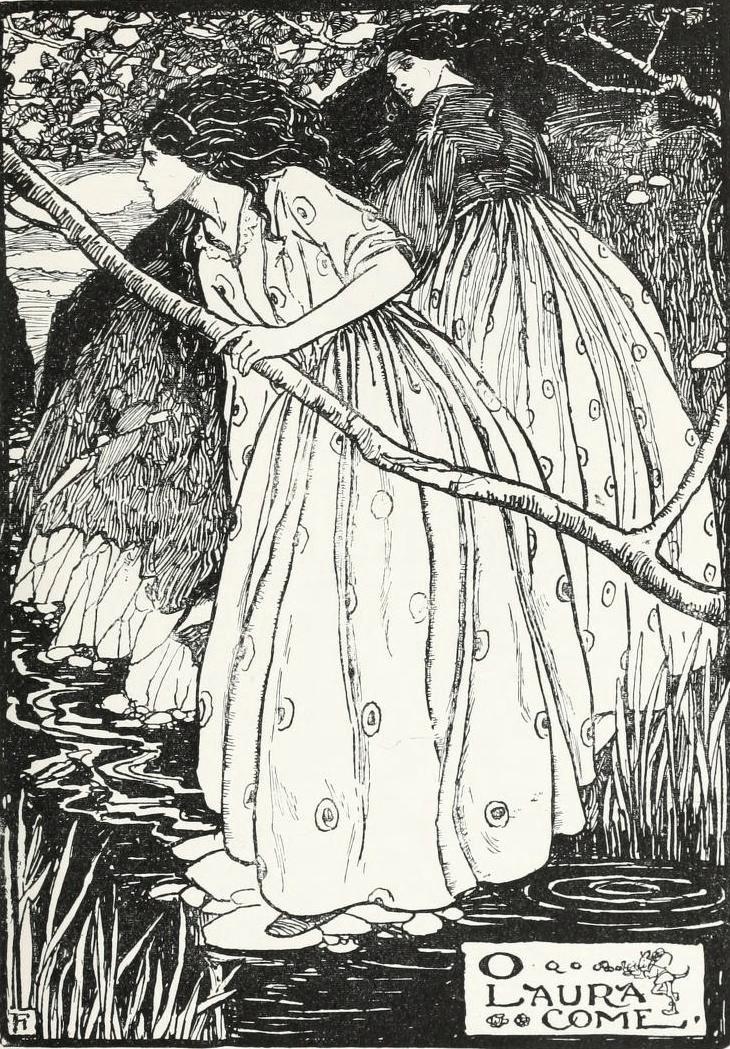
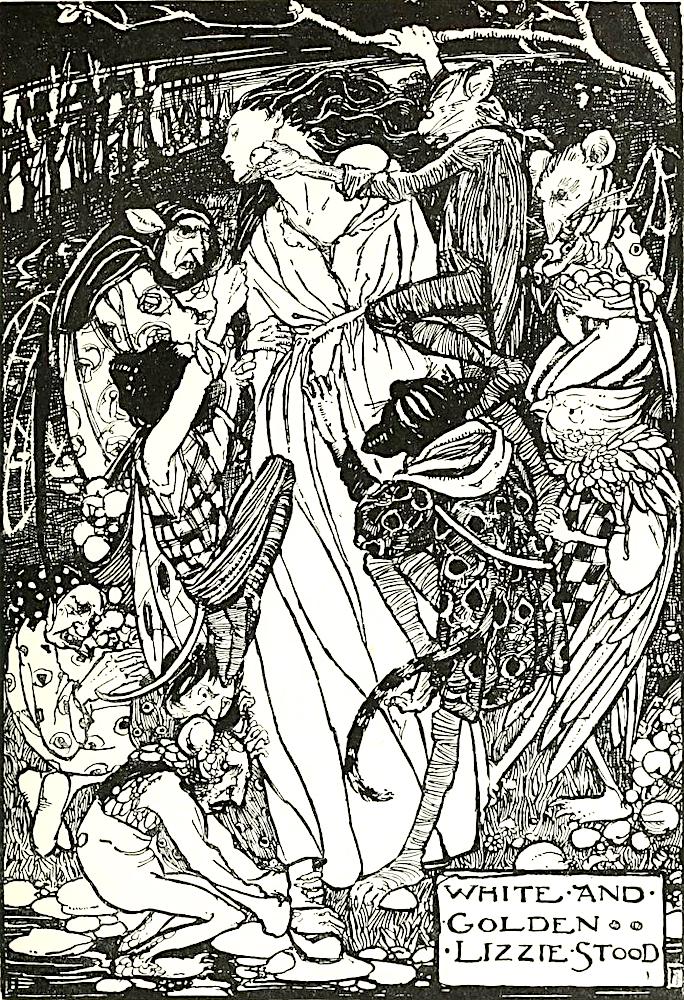
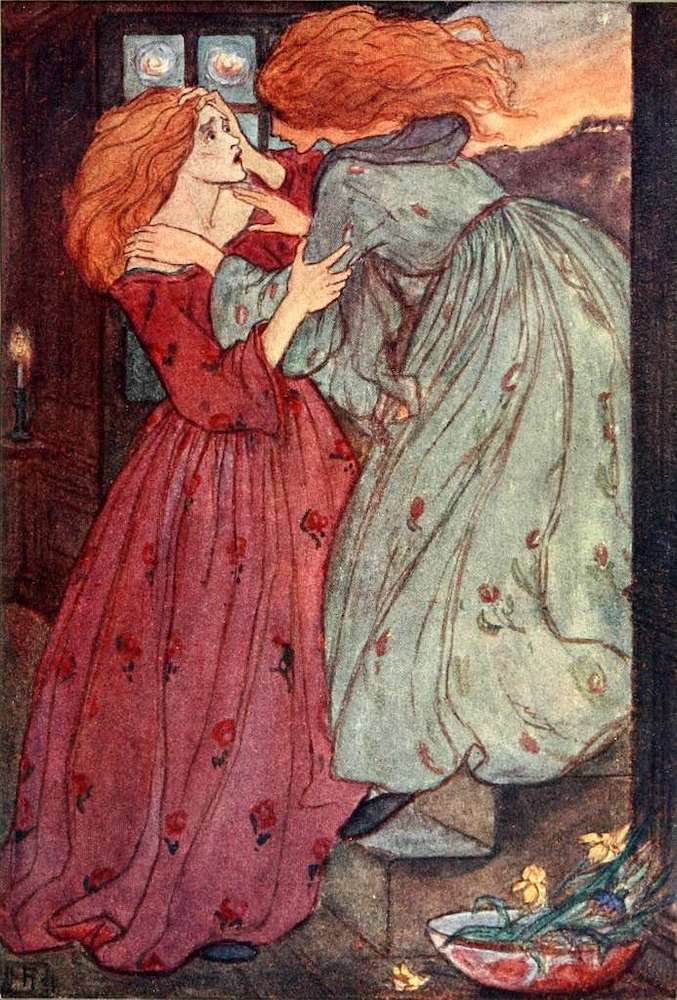
Three illustrations by Florence Harrison from a copy of Poems of Christina Rossetti (here dated 1910) in the University of British Columbia's library, digitised in the Internet Archive. From left to right: (a) 'O Laura Come', facing p. 8. (b) 'White and Golden Lizzie Stood', facing p. 16. (c) 'For your sake I have braved the glen /And had to do with goblin merchant men', facing p. 20).
For her part, children's book illustrator Margaret Tarrant would abstain from such explicitness. Her illustrations, published in 1912 as well, draw on the fairy-tale tradition, with goblins transformed into fantastical creatures. Tarrant modestly clothes the sisters, who are dressed from head to toe, apron and bonnet included to give a sense of modesty and domesticity. Tarrant chooses to depict the moment following Laura's restoration to health with the sisters modestly embracing, while Laura gives a chaste kiss to Lizzie's cheek, erasing all homoerotic tension. In fact, Tarrant eliminates any violence or sexual imagery. In fairy-tale renditions of 'Goblin Market', there seems to be a clear contrast between the safety of the domestic sphere, where women are mostly relegated, and the woods, where temptations take place. In the same line, Ellen Raskin published her adapted and illustrated edition in the 1970s. Raskin delivers children a purely innocent fairy-tale world of bright watercolours. The illustrator decides not to portray the sisters as twin-like, as a means of visually representing the morally good and morally bad sister. Laura's restoration to health offers an image with no sexual ambiguity, where we see Lizzie motherly-like nursing Laura in her arms. Sisterhood acquires motherly attributes in this fairy-tale edition.
Our next female illustrator is Kinuko Craft, whose sexually explicit images clearly show Rackham's influence. Published in 1973 in Playboy, her illustrations centre on lust and sexuality, delivering adult erotica. There is an overemphasis of Rossetti's ambiguities, above all concerning lesbianism, anticipating later scholarly work on such themes. The illustrator's focus is on female sexual pleasure, which is once delivered through the goblins in their orgy with Laura, but then obtained between the sisters as incestuous lesbianism. Lizzie's call 'Hug me, kiss me, suck my juices' is literally represented as a homoerotic encounter between the sisters, an orgasmic event which ultimately provides the cure for Laura. Thus, the concept of sisterhood is transformed by Craft in an incestuous sexual relationship, and lesbianism is offered as cure and supreme medium for sexual pleasure – at least for the male gaze, considering Playboy's main audience. Henceforth, nudity will be a common feature in illustrated editions in the twenty-first century. Hilary Paynter published in 2003 her black-and-white engravings, where her notion of sisterhood goes beyond previous illustrators': her goblins are depicted as human men, far from the anthropomorphic animals or fairy-tale creatures in preceding illustrations. Men, therefore, become the real threat for women, as her depiction of the attack on Lizzie demonstrates. Her portrayal of the sisters is always full of homoeroticism, since we see them embracing or kissing each other's lips. Lesbianism seems to be offered once more as cure as opposed to the sexual temptation and danger portrayed by men.
The next publication of a 'Goblin Market' illustrated edition was also by a female artist. Published in 2010, Jillian Tamaki shows Lizzie and Laura partly nude in some images, and homoerotic undertones are visible in the way the sisters interact with each other. Most interestingly, the focus for Tamaki are the sisters, who dominate her images, and their relationship. Goblin men do not appear, and we only get to see their threatening eyes among the fruit.
Lastly, in November 2021 Batsford published a new illustrated edition by British artist Georgie McAusland:
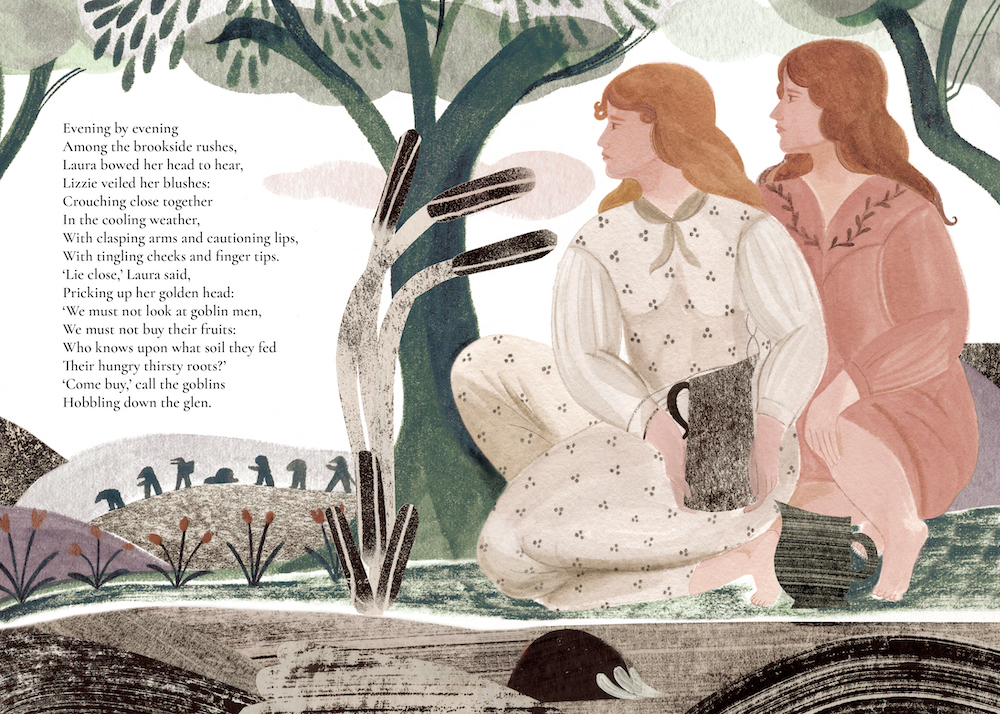
McAusland, ‘Evening by Evening’.
There is no trace of eroticism in her drawings and the central point are again the sisters, or female characters in general, as it is also the first time that Jeanie appears in illustrations. Yet her focus is on women, but not on their bodies, abstaining from commodifying or sexualising the female body as previous works. The illustrator distances herself from preceding artists and chooses to be more subtle in her treatment of the most dramatic moments. Just as described by Rossetti, McAusland portrays Laura shedding a tear when clipping her hair in exchange for the goblin fruit, giving women's feelings their appropriate place too.
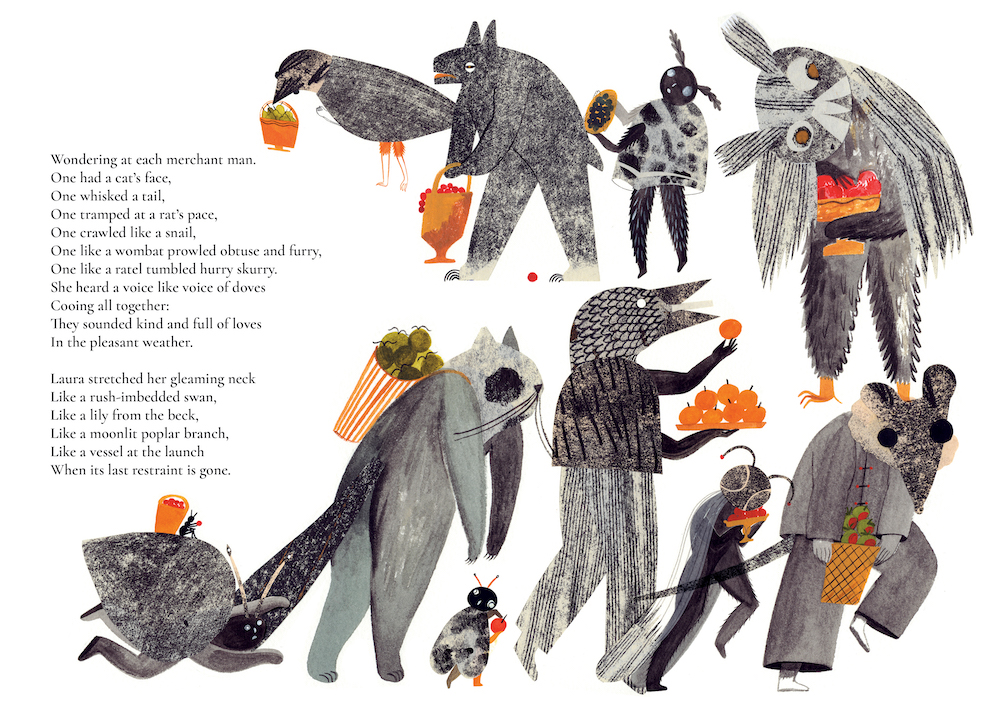
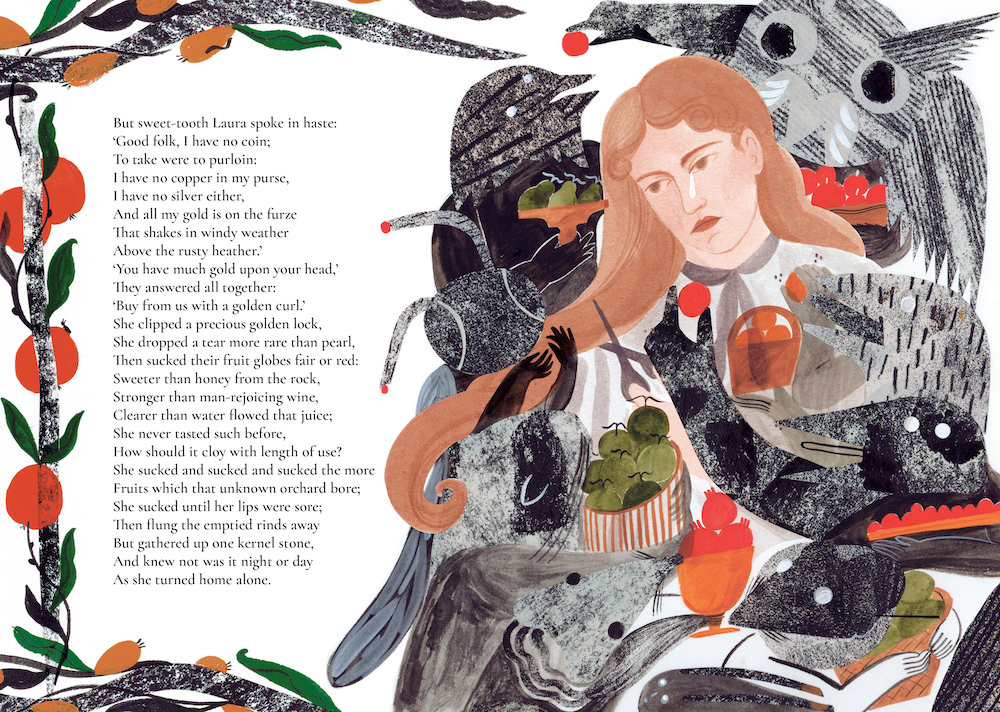
Left: McAusland’s take on the goblin men. Right: McAusland, ‘The Temptation of Laura’.
The illustrator revels in the depiction of Rossetti's metaphors, employing symbolic visual language. An example can be seen following Lizzie's triumph over the goblins, where her bruises and scars make her the paradigm of sexual harassment and abuse survivor, very in line with the feminist #MeToo movement. McAusland underscores Lizzie's resistance and survival, rather than focalising on a sexualised portrayal of the attack, as in previous illustrations. Her images offer very interesting depictions of the sisters, for she presents us with two strong characters who suffer but whose love for each other is constantly felt. That can be observed in Laura's restoration to health, where we see the cure provided by Lizzie and how it runs inside Laura's veins and heart until she is finally recovered. It is a beautiful portrayal which highlights the importance of sisterhood given by Rossetti in her poem. After that, Laura looks like her own sister, as their hair colour becomes almost identical.
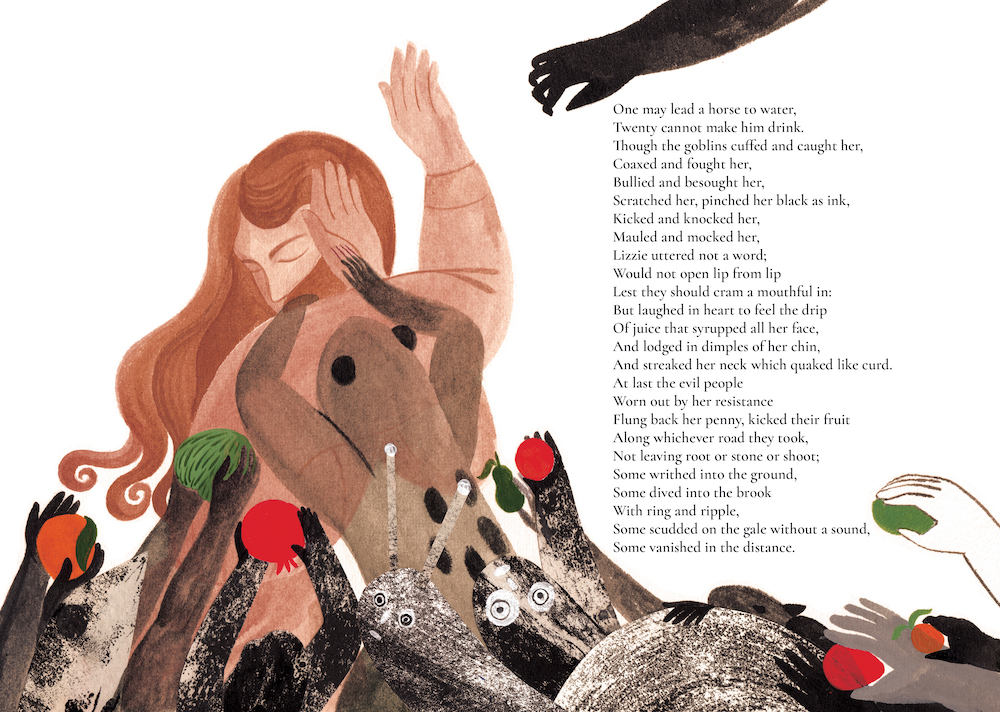
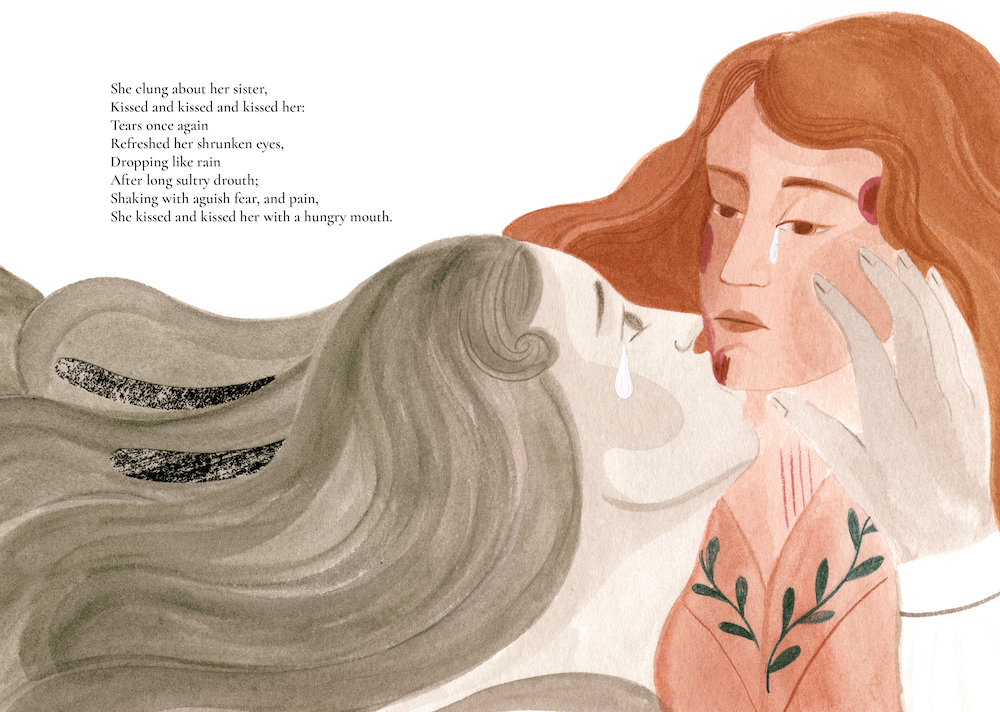
Left: McAusland, ‘The Assault on Lizzie’. Right: McAusland, ‘Lizzie and Laura’.
McAusland closes the poem illustrating the last lines, which accord a great importance to sisterhood: Laura tells her story to two little girls, and we observe that the narrative of female empowerment is rooted within her, and branches bearing fruit come out of her mouth to spread the importance of sisterhood to future generations.
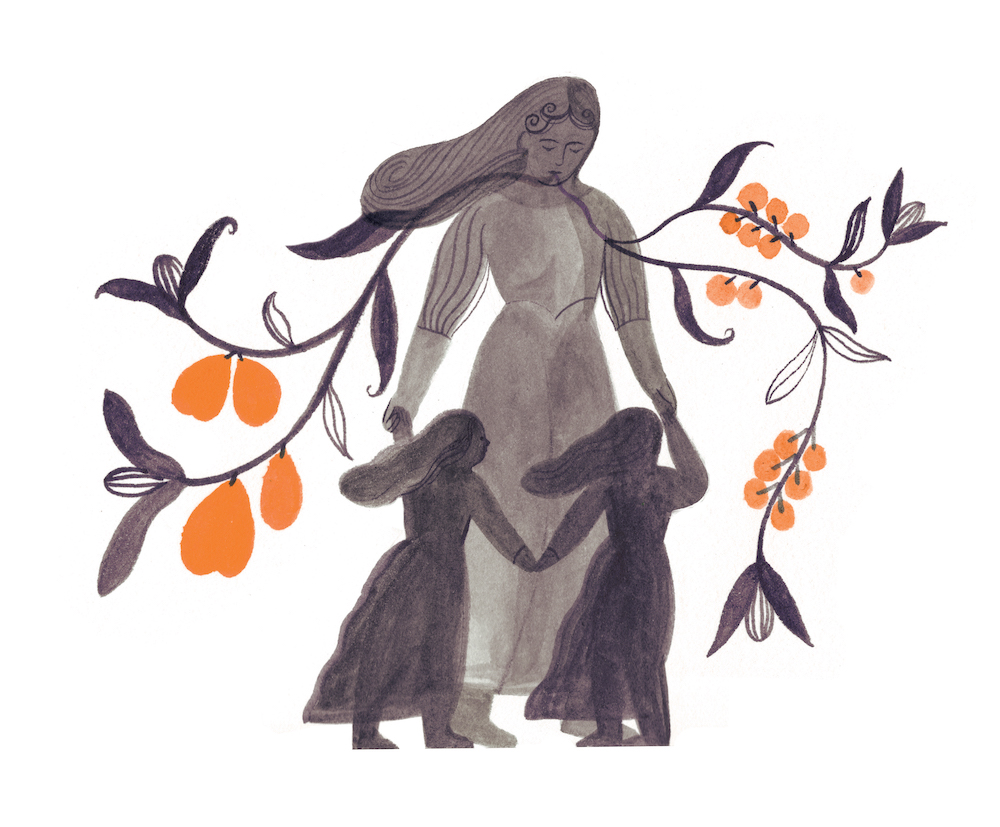
McAusland, ‘Laura and her children'.
Musicians have also shown their interest in Rossetti's 'Goblin Market', at times leading us to new interpretations and anticipating themes and new readings. English composer Ruth Gipps was the first female musician to transfer Rossetti's verses into music. Her cantata entitled Goblin Market Op. 40 (1954) distances itself from the more conventional and moralistic adaptations previously written by Emanuel Aguilar and Vittorio Ricci. Anticipating the feminist critical recuperation of Rossetti's 'Goblin Market' in the 1970s, Gipps provides a feminist reading highlighting the sensuousness and eroticism of the poem. Gipps concentrates on the female experience and sexuality, with a strong stress on the sisters. Interestingly, in her feminist conception, Gipps decides to transform the poem's ending, which sees Laura and Lizzie as married women, deleting the explanation of the importance of sisterhood. The musical composition simply finishes after Laura's restoration to health, eliminating what could be seen in the 1950s as women merely conforming to the social impositions established by patriarchal society; but the cantata retains the relevance of solidarity among women.
In the 1980s, 'Goblin Market' would be first introduced to a new genre: the musical theatre. Polly Pen and Peggy Harmon wrote in 1985 Goblin Market>, shown off Broadway. In their adaptation, just as in Tamaki's illustrations, Pen and Harmon eliminate the presence of the goblins and concentrate solely on the sisters and their relationship. The female world and experience are once again the absolute focus of this musical composition, where themes such as the female psyche, sexual desire, innocence, and aging are explored. The production portrays Lizzie and Laura as mature sisters who reminisce about their childhood fantasies. Rossetti's narrative is filtered through the memories and imagination of these two sisters, who are represented for the first time as adults. That is why the goblin men are not physically present: it is Lizzie and Laura who in turn enact the sexual temptation and threats these goblins imply for them. This modification involves an emphasis on the psyche of the sisters, for the temptations are in their mind, not in the real world.
Pen and Harmon place a great emphasis on differentiating the sisters, who are divided into the braver and more 'masculine' (Laura) and the more fragile and 'feminine' (Lizzie). The show eliminates fragments from Rossetti's 'Goblin Market' which may lead to homoerotic readings, underscoring, on the other hand, a rivalry between the sisters. The duet 'The Sisters' is a clear example of that sibling rivalry, which seems to contradict the prominence of sisterhood in the poem and other artistic representations. Nevertheless, as previously stated and as Weltman argues, other changes in the production lead to homoerotic connotations, because of the 'trans-gender performativity' of the play, since the elimination of the goblin presupposes that it is the sisters who impersonate them (Weltman 162). Different productions based on this musical theatre have made their own re-interpretations, addressing diverse aspects, and engaging with their own social contexts. The twenty-first century has also seen new adaptations of Rossetti's poem into musical theatre, as the one written in 2003 by Kath Burlinson and Conor Mitchell. Goblin Market was composed for six female soloists, a large chorus, and orchestra, with all the main roles played by girls. This production focuses on the sisters' youth, as Rossetti does in her poem, and chooses accordingly a young cast. The female experience takes the centre stage in this adaptation again, where we are transported to a world dominated by female characters. This musical was last performed in 2021 by the British Youth Music Theatre, attesting to the everlasting presence of 'Goblin Market' in our contemporary arts.
Conclusion
Christina Rossetti is a poet who is plainly aware of the devices and techniques which make her poetry awash with sensory experiences, filling her verses with a musicality and visuality which haunt the imagination of her readers for a long time. Her incantatory lines and the ambiguity which surrounds them creates a poignant atmosphere which attracts readers and artists to its core. Some have been enticed to its sensuousness, thriving on its sexual and (homo)erotic tensions and exploiting them so as to provide lesbian readings on these passages. More generally, female artists have underscored themes of sisterhood in different manners, some of them presenting twin-like sisters as two sides of the same coin, or focusing on the suffering, survival, and final redemption of the sisters, while others replace sisterhood with lesbianism or sibling rivalry. It is most interesting to observe how some female artists have even decided to eliminate the presence of the goblins, fixing their attention solely on the female experience, which is the cornerstone for most female artists. All these visual and musical adaptations enable us to delight in the sister arts in a very Pre-Raphaelite conception. In sum, illustrators and musicians have re-presented and interpreted the poem according to their own contemporary concerns, exerting some dominance over the text and linking the poem with their own reality.
Bibliography
Marsh, Jan, Christina Rossetti: A Literary Biography. London: Faber & Faber, 2012.
Roe, Dinah, An Introduction to 'Goblin Market' (2014), British Library
Rossetti, Christina Georgina, The Poetical Works of Christina Georgina Rossetti, ed. by William Michael Rossetti. London: Macmillan, 1904.
_____. Goblin Market, illustrated by Margaret Tarrant. London: Routledge, 1912.
_____. Goblin Market . Blackie's English Classics, illustrated by Florence Harrison. London: Blackie and Son, 1912.
_____.'Goblin Market: Ribald Classic', illustrated by Kinuko Craft, Playboy 20.9 (1973): 115-119.
_____. Goblin Market , illustrated with Wood Engravings by Hilary Paynter. London: Artists' Choice Editions, 2003.
_____. Goblin Market, illustrated by Jillian Tamaki. London: The Folio Society, 2010.
_____. Goblin Market , illustrated by Georgie McAusland. London: Batsford, 2021.
Weltman, Sharon Aronofsky. Victorians on Broadway: Literature, Adaptation, and the Modern American Musical. Charlottesville: University of Virginia Press, 2020.
Biography
Ester Díaz is a PhD Fellow in English Literary Studies at the Universidad Nacional de Educación a Distancia (UNED), Spain, where she holds a FPI grant. She is a member of the Pre-Raphaelite Society, where she helps with publicity and marketing. Her doctoral research focuses on the study of poetic language and how it can be translated, adapted, or transferred into other languages or artistic means such as painting and music. Her main research interests include transmediation, adaptation and translation studies, as well as the sisterhood of the arts.
Created 2 February 2023
Last modified 14 February 2023 (illustrations added)